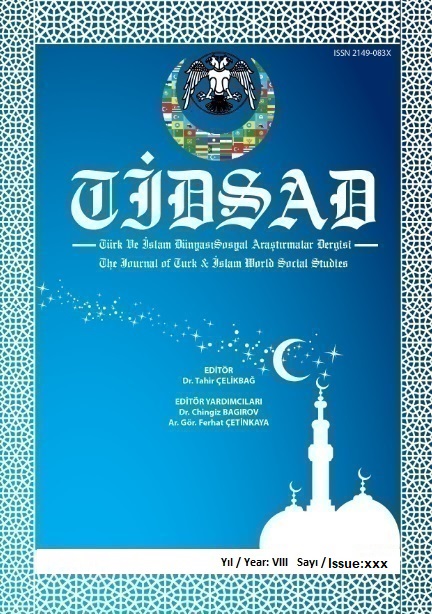Author :
Abstract
Çalışmada Azerbaycan’ın başkenti Bakü’de bulunan ve şehrin önemli yapılardan biri olan İsmailiye Sarayı’nın eski hali ve restorasyon sonrası durumu incelenmiştir. 1908-1913 yılları arasında Azerbaycan’ın zenginlerinden Ağa Musa Nağıyev tarafından yapılmış olan bu saray çeşitli zamanlarda tarihi olaylara şahitlik etmiştir. 1918 Mart olayları sırasında hasar gören bina neredeyse tamamen yok edilmiştir. Birkaç sene sonra Sovyet Sosyalist Cumhuriyetler Birliği binayı yıkma kararı alsa da, yerel halkın itirazı nedeniyle binanın restorasyonuna başlanılmıştır. Binayı restore eden Sovyet iktidarı her zaman olduğu gibi yine bu sarayda da kendi izlerini bırakmaya çalışmıştır. Yapılan çalışmada nicel bilimsel araştırma yöntemlerinden nedensel-karşılaştırma yöntemi kullanılmıştır. Çalışmanın sonucunda İsmailiye Sarayı’nın geçirmiş olduğu restorasyon sürecinde özgün halini koruyamadığı görülmüştür.
Keywords
Abstract
The historical condition of the Ismailiye Palace, which is located in Baku, Azerbaijan's capital, and is one of the city's most prominent monuments, was compared to its current form following restoration in this research. This palace, which was built between 1908 and 1913 by Aga Musa Nagiyev, one of Azerbaijan's wealthiest men, has seen several historical occurrences. The building was nearly totally destroyed during the events of March 1918. Despite the fact that the Union of Soviet Socialist Republics intended to destroy the building a few years later, due to local opposition, the restoration of the structure began. The building was renovated by the Soviet administration. The Soviet administration, which rebuilt the structure, attempted, as it usually did, to stamp its imprint on it. The causal-comparison method, a quantitative scientific research method, was employed in the study. The analysis revealed that the Ismailiye Palace would not be able to maintain its original state during the restoration procedure.
Keywords
- Aliyev, İ. (2007). “Memarlıq”. Azərbaycan Mıllı Ensiklopediyası, Bakü. s. 750-760.
- Amanoğlu, E. (2005). “Bakü'de Ermenilerin Yaptıkları Soykırım (Mart 1918) ve Edebiyatta Yansımaları”. Karadeniz Araştırmaları(5), s.99-107.
- Boni, F. D. (2018). “Baku and Architecture: From Soviet Building to Archistars”. Geopolitical, Social Security and Freedom Journal, 1(2), s.76-83.
- Budak, A. (2018). “Müsavat Partisinin 1911 – 1922 Yılları Arasındaki Faaliyetleri”. Fırat Üniversitesi Sosyal Bilimler Dergisi, 28(2), s.333-343.
- Durmaz, Ş. (2010). “20.Yüzyılın Başında Azerbaycan’da Sosyal Yardımlaşma ve Dayanışma Amaçlı Vakıf ve Dernekler”. Türkiye Cumhuriyeti Başbakanlık Sosyal Yardımlaşma ve Dayanışma Genel Müdürlüğü Yardım ve Dayanışma Hakemli Araştırma Dergisi, 1(1), s.61-69.
- Dursun, D. (1991). “Bakü Azerbaycan Cumhuriyeti’nin Başşehri”. TDV İslam Ansiklopedisi, 4, s.550-551.
- Erdoğan, F. (1998). Türk Ellerinde Hatıralarım (buraxılış 1.Baskı). Ankara: T.C.Kültür Bakanlığı Yayınları .
- Ferhadoğlu, K. (2006). Bakı. İçərişəhər. Bakü.
- Fetullayev-Figarov, Ş. (2013). Memar İ.K.Ploşko-"İsmailiyyə"nin Müəllifi. Bakü: Ami.
- Giyasi , C. (2015, 04 03). “Ortaçağ Azerbaycan Mimarisi”. İrs Sanat Dergisi,, s.50-57, http://www.azbtt.com/pdf/1469527298-7h6dgoclui-12.pdf
- Quretski, V. (2012). Bakı: Bakıda Polyak məkanları. Bakü: Polşa Respublikasının Bakıdakı Səfirliyi.
- Resulzade, M. E. (1990). Azerbaycan Cumhuriyeti Keyfiyet-i Teşekkülü ve Şimdiki Vaziyeti. İstanbul: İrfan Yayınevi.
- Seyid, N. (2021). İsmailiyyə Sarayı İkinci Mərtəbə. Bakü.
- Sipahi, E. B. (2018). “Bakü’nün Başkent Olma Süreci Üzerine Bir Analiz.” Müsəlman Şərqində ilk Parlamentli Respublika, Bakü. s. 982-989.
- Fetullayev-Figarov, Ş. (2013). “İçeri Şeherin Etrafı Boyunca Dairevi Magistral.” Bakının Memarlıq Ensiklopediyası. Bakı:Azerbaycan Respublikasının Memarlar İttifaqı.
- Tofiqoğlu, A. E. (2010). Bakı Memarlıq Abidələrində Fasad Heykəltəraşlıq Nümunələri: XIX Asrin Sonu-XX Asrin Əvvəlləri. Bakü.
- URL-1. (2021, 03 02). İsmailiye Sarayı. Bu Wikipedia: https://az.wikipedia.org/wiki/%C4%B0smailiyy%C9%99_Saray%C4%B1
- URL-2. (2021, 04 03). Azıx mağarası. Bu Azərbaycan Respublikası Xocavənd Rayon İcra Hakimiyyəti: http://www.xocavend-ih.gov.az/page/141.html
- URL-3. (tarixsiz). 7 7, 2021 tarixində bu Wikipedia: https://tr.wikipedia.org/wiki/Azerbaycan_mimarisi
- URL-4. (2021, 06 22). Dərbənd qalası. Bu Tarix.info: https://tarix.0101.az/abideler/80- d601rb601nd-qalas305.html
- URL-5. (2021, 06 22). Yuxarı Karvansaray. Bu Wikipedia: https://az.wikipedia.org/wiki/Yuxar%C4%B1_Karvansara_(%C5%9E%C9%99ki)#/me dia/Fayl:Yukhari_kervansarai_2.JPG
- URL-6. (2021, 06 22). Bakı. Hökümət evi. Tarix və miras. Bu Az Loqos: https://azlogos.eu/baki-hokum%C9%99t-evi-tarix-v%C9%99-miras/
- URL-7. (2021, 06 19). Nizami kinoteatrı. Bu Nostalgiya: https://nostalgiya.az/azerbaycan/754- nizami-kinoteatri-baki-1961-ci-il.html mənbədən tapılıb
- URL-8. (2021, 04 11). Haydar Eliyev Kültür Merkezi. Bu Arkitektuel: https://www.arkitektuel.com/haydar-aliyev-kulturmerkezi/zha_heydar_aliyev_centre_baku_huftoncrow_001 mənbədən tapılıb
- URL-9. (2021, 06 21). Baku Flame Tower. Bu KOPRULULER INC.: https://koprululer.com.tr/projeler/baku-flame-tower/
- URL-10. (2021). Xəsis milyonçu Musa Nağıyev və Bakının "qızıl binası". Bu https://www.kultura.az/az/article/2654/
- URL-11. (2021, 06 28). İsmailiyya building. Bu Can stock photo: https://www.canstockphoto.com/ismailiyya-building-in-baku-azerbaijan-79076020.html
- URL-12. (2021, 06 28). Жемчужина бакинской архитектуры «Исмаилия». Bu Окна в Баку: https://www.window2baku.com/ismailiya.htm
- URL-13. (2012). "Bakı vaxtı - İsmailiyyə binası" filmi - İctimai TV. Haziran 28, 2021 tarixində bu https://www.youtube.com/watch?v=A8nz-jWkfmA mənbədən tapılıb
- URL-14. (tarixsiz). Temmuz 7, 2021 tarixində bu https://www.baku.ru/enc- show.php?id=141832&cmm_id=276&slang=ru
- Valiyev, A. (2013). “Baku”. Cities, 31, 625-640.
- Yagublu, N. (2015). Mehmet Emin Resulzade Ansiklopedisi. Ankara: “Azerbaycan Kültür Derneği” Yayınları.





